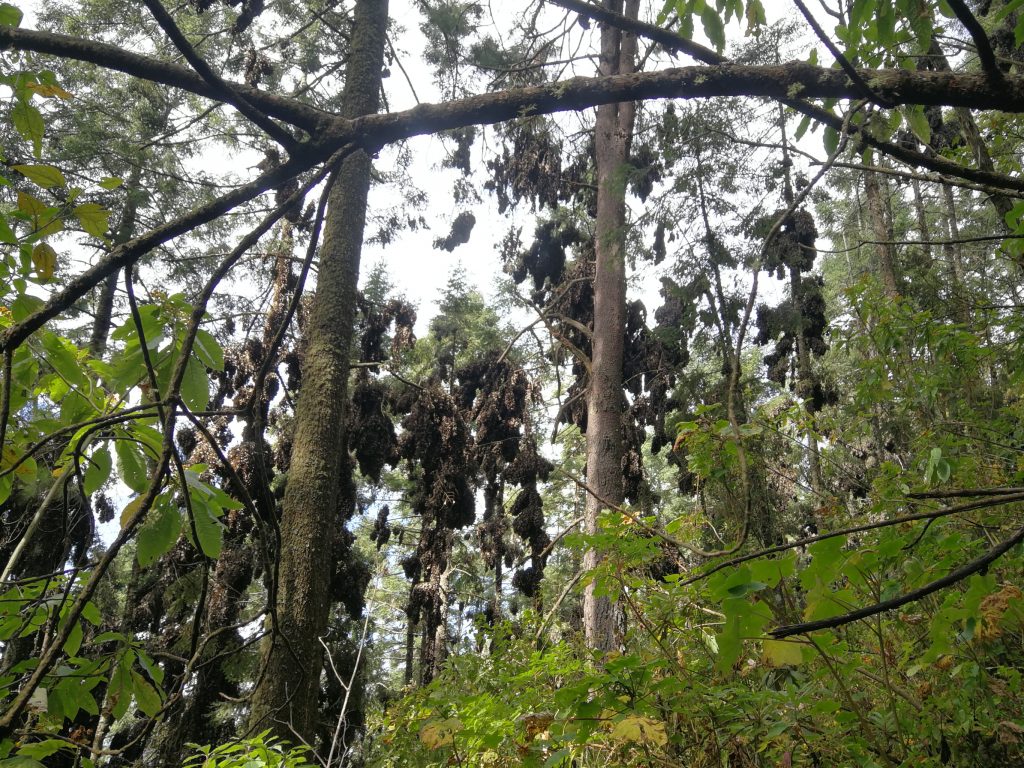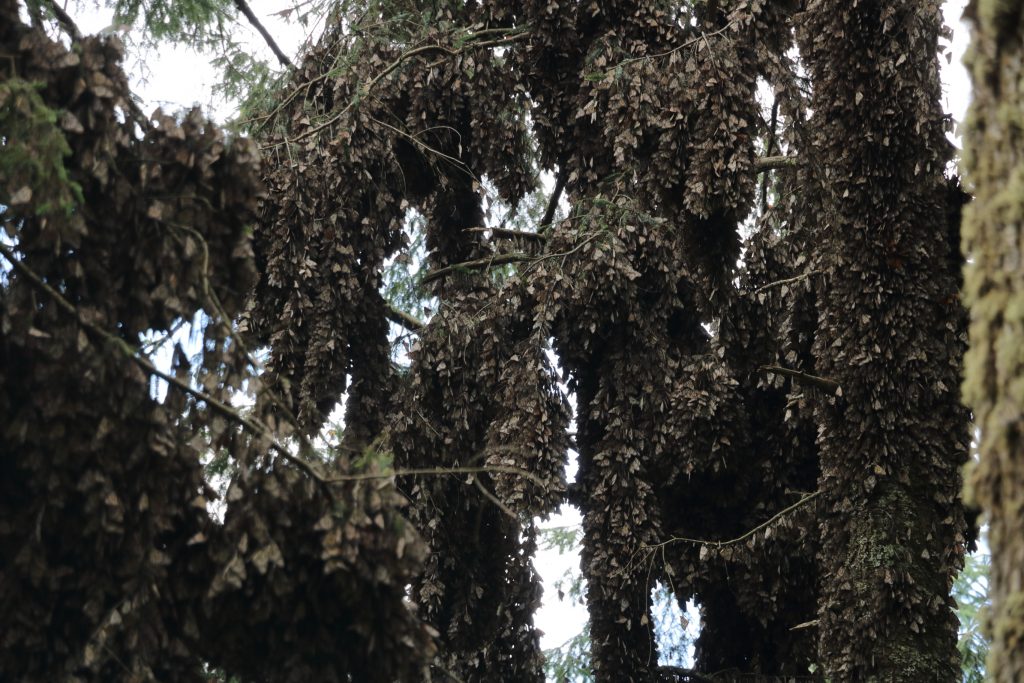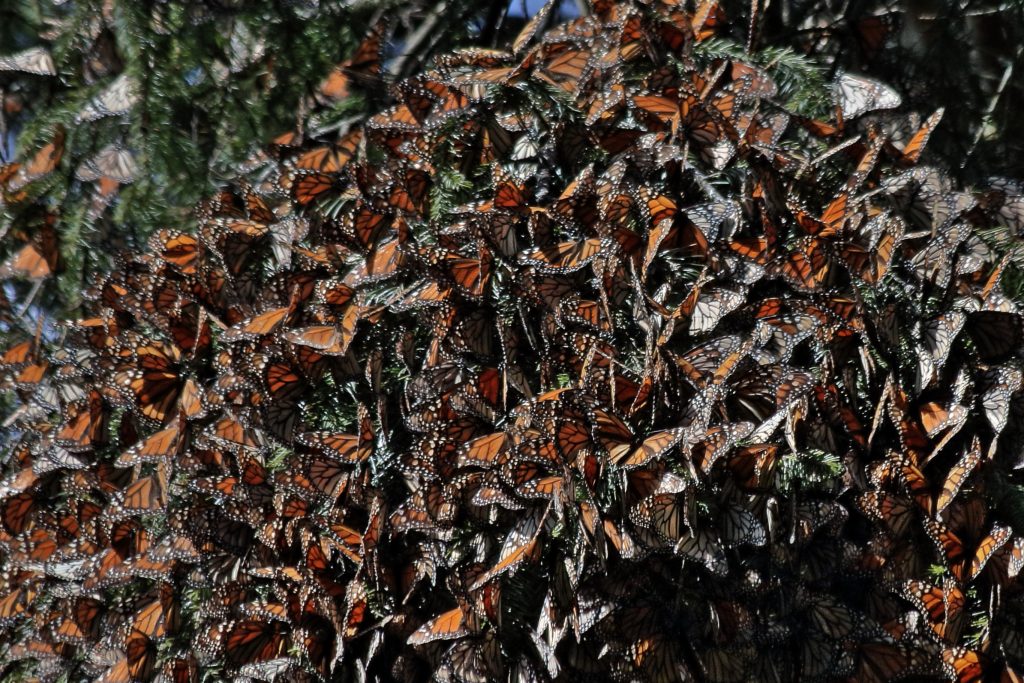Central Mexico, mid-late winter… it’s the baffling Monarch butterflies migration season. No exaggeration… millions of them. These little chaps are a Mexico bucket-list item for us and a prime example of the inexplicable natural world. In any case, we’ve got a bit of time on our hands still waiting for a new windscreen, so we do a 1,500km loop to see them. While we’re at it, we include a short volcano crater hike at over 4,200m asl (breath-taking in more ways than one) and we follow the trail of Mexican revolutionary hero, Emiliano Zapata.

Monarch Butterflies Story
The Monarch butterflies hail from USA/Canada, but like many North Americans they head to Mexico for the winter. I don’t think they come here for the tequila, but it is warmer down here and the food is better, so it’s a no-brainer for them really. Around October each year they set-off south in their millions. By early December they’re here enjoying the sunshine and tacos for the winter.
In March the Monarch butterflies start heading back north for the summer, but they don’t live long enough to make it all the way back. On the way they stop-off, lay eggs, reproduce, then die. Three or four generations of Monarchs will pass before the north-bound journey is complete, the summer has passed, and the next annual cycle of migration is ready to start. The last generation of the summer season – the ones that migrate south to Mexico again – do not reproduce on the 4,800 km trip south. These guys and gals reach Mexico and only become reproductive in Feb/March just as they move north again.


All rather fascinating. But here’s the really impressive bit… the southbound migrating Monarch butterflies go back to exactly the same spots, often exactly the same trees, that their ancestors left three or four generations previously. How on earth do they know where to go? How do they know… that people like us are waiting to see them at one of only four hillside spots that their predecessors left just eight months earlier. Who knows? It is known that magnetic-fields guide them in a general direction, but here’s the thing…. they don’t just return to a general, sunny area of Mexico. They return to the same hillside, the same trees when they have never been there before! That’s an impressive bit of navigation. We occasionally get lost even with the assistance of a sat nav Wallace and Gromit GPS in the truck.
Monarch Millions
We really, really (really!) wanted to see these little marvels in at least one of their four gathering sites. We started at the most northerly site, Chincua where we hiked a couple of kilometres and saw tens, probably hundreds of thousands – of butterflies. Problem is… they were all huddled up in huge clumps in the trees. It was a cool day and cloudy. We had been warned that if the sun didn’t come out to warm them, they wouldn’t fly – they would just huddle together in the trees for warmth. It was fascinating to see them all there, and one or two of them did venture out for the odd flutter, but it didn’t really do it for us. We had to try again.



Next, we went to the nearby Cerro Pelón. A hot, sunny day with clear-blue skies. Bingo! It’s apparently a long, steep hike to the nesting site; given the high altitude we decided to take horses. Turns out we could have walked. It was such a great day that the Monarch butterflies had not only flown out of their trees, they had come flocking (do butterflies ‘flock’?) down the mountainside to drink dew and scoff pollen in the lower meadows. Astonishing! We got off our horses and walked around (it must be said, in a little discomfort – our backsides are not accustomed to being ‘in the saddle’ 😊) completely surrounded by swarms of exquisite, bright orange butterflies.
They were flying all around us, plus so many more carpeted the floor there was hardly space to place our feet. They had no fear and didn’t fly away as we approached… just mind-blowing! They make a noise too. A single butterfly is silent, but thousands and thousands flying all together in close proximity make a distinct buzzy-fluttery sound. This is what we came for! We happily climbed back into the saddle to punish our backsides on the descent.



The day at Cerro Pelón had been so good we couldn’t resist the opportunity to hunt down a few more – this time at Piedra Herrada site. The conditions weren’t as perfect as they had been at Cerro Pelón, but better than they had been at Chincua. Here we saw them kind of half-and-half: half clumped-up in the trees, half soaring around the nests and the tree-tops. This wasn’t a disappointment – we were pleased to have seen the Monarch butterflies at three sites in three different states: nested, semi-nested and totally in dispersed from the nests. Each was special in its own way, but even more special when you know the mystery-story of how they got there. Here’s our video, but for more info from National Geographic click here.
Nevado de Toluca
We’re happy bunnies after the butterfly experience, and even happier when a carrier pigeon tells us that our new windscreen will arrive in Oaxaca at the end of the week. This is good news, but we’ve learned over the last three months not to get too excited (long story… this is now the second windscreen that we are attempting to receive in Mexico since mid-December!). So we need to head south again and have chosen a route passing the volcanic crater in the Nevado de Toluca.

The drive to the car-park takes us up to around 4,000m (13,700ft) then the hike starts. The basic trek up to the rim, down into the crater and around the lake looks tame enough on paper. It’s only around 5.5km and not exceptionally steep but if, like us, you happen not to have acclimatised to the altitude, you can expect it to take your breath away. Fortunately, the spectacular scenery is also breath-taking and makes the effort worthwhile. Afterwards we descend to 2,700m to sleep in Toluca city, finding the convenient ‘beauty’ of a Walmart carpark 😒.


Ruta Zapata
Still routing back south, we spot signs for the ‘Ruta Zapata’. Emiliano Zapata was one of Mexico’s heroes-of-the-people in the early 20th Century, fighting for the rights of peasants and land-workers. We’re suckers for a revolutionary under-dog hero story. Way back in Bolivia a couple of years ago we enjoyed a similar type of historic-route-thing following the trail of South American revolutionary Che Guevarra. So we thought we’d give Zapata’s story a whizz.


Well… Ruta Zapata doesn’t impress in quite the way of El Che’s trail. Unfortunately, the main museum was damaged badly in the 2017 earthquake and can’t open to the public. But there are some interesting stops on the route and a helpful guide took us around one of the sites to explain the story. It’s worth doing if you happen to be passing south of Cuernavaca, but don’t make a special de-tour
Wonder-when Windscreen
Heading back to Oaxaca (again) we have the optimistic hope of receiving a windscreen. Oh how mistaken can we be??? The promised deliver of “Friday 22nd February at the latest” has been and gone. Nothing. Nada. Nichts. Zilch. Maybe next week? Tune in to the next instalment
Monarch Butterfly Loop-Trip Gallery

















